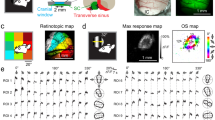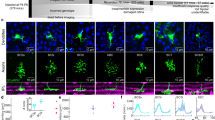Abstract
Behavioural tests1–4 have demonstrated that cephalopods can discriminate light polarized in different planes, and the receptors have been localized by electrophysiological studies of the eye5–10. Discrimination of the plane of polarization is a consequence of both the structure of the microvilli in the outer segments of the photoreceptors11 and the orientation of the photosensitive chromophore on these membranes2,12,13. However, between the depolarizing receptor response resulting from photoreception and the behaviour of the animal, nothing is known about neuronal processing of polarized light by cephalopods. Here we show that some squid photoreceptors discriminate the plane of polarization within the spike train, and that any particular plane is seen as a variable intensity. Given the well known orthogonal orientation of microvilli in outer segments of adjacent photoreceptors and the physiological preference for one of two mutually perpendicular planes of polarization by single photoreceptors, we conclude that cephalopod vision is based on two complementary views of the world, each determined by the transformation of polarization-sensitive receptors into complementary intensity scales. A visual system based on this transformation would lead to enhanced contrast underwater and visualization of object details obscured by confounding highlights.
This is a preview of subscription content, access via your institution
Access options
Subscribe to this journal
Receive 51 print issues and online access
$199.00 per year
only $3.90 per issue
Buy this article
- Purchase on Springer Link
- Instant access to full article PDF
Prices may be subject to local taxes which are calculated during checkout
Similar content being viewed by others
References
Moody, M. F. & Parriss, J. R. Nature 186, 839–840 (1960).
Moody, M. F. & Parriss, J. R. Z. vergl. Physiol. 44, 268–291 (1961).
Rowell, C. H. F. & Wells, M. J. J. exp. Biol. 38, 827–831 (1961).
Jander, R., Daumer, K. & Waterman, T. H. Z. vergl. Physiol. 46, 383–394 (1963).
Lettvin, J. Y. Q. Prog. Rep. Res. Lab. Electron. M.I.T. 64, 288–290 (1962).
Tasaki, K. & Karita, K. Nature 209. 934–935 (1966).
Tasaki, K. & Karita, K. Jap. J. Physiol. 16, 205–216 (1966).
Tomita, T. Proc. IEEE 56, 1015–1023 (1968).
Saidel, W. M. Biol. Bull. 159, 490 (1980).
Suguwara, L., Katagiri, Y. & Tomita, T. J. Fac. Sci. Hokkaido Univ. Ser. VI 17, 581–586 (1971).
Waterman, T. H. in Handbook of Sensory Physiology Vol 7/6B (ed. Autrum, H.) 281–469 (Springer, Berlin, 1981).
Tauber, U. in Photoreceptor Optics (eds Snyder, A. W. & Menzel, R.) 296–315 (Springer, Berlin, 1975).
Schlecht, P. & Tauber, U. in Photoreceptor Optics (eds Snyder, A. W. & Menzel, R.) 316–335 (Springer, Berlin, 1975).
Lange, G. D. & Hartline, P. H. J. comp. Physiol. 93, 19–36 (1974).
Pinto, L. H. & Brown, J. E. J. comp. Physiol. 122, 242–250 (1977).
Wolken, J. J. J. biophys. biochem. Cytol. 4, 835–838 (1958).
Young, J. Z. Nature 186, 836–839 (1960).
Zonana, H. V. Bull. Johns Hopkins Hosp. 100, 185–205 (1961).
Yamamoto, T., Tasaki, K., Sugawara, Y. & Tonosaki, A. J. Cell Biol. 25, 345–359 (1965).
Cohen, A. I. J. comp. Neurol. 147, 351–377 (1973).
Bernard, G. D. & Wehner, R. Vision Res. 17, 1019–1028 (1977).
Young, J. Z. Phil. Trans. R. Soc. B245, 1–18 (1962).
Lund, R. D. Expl Neurol. 15, 100–112 (1966).
Lange, G. D., Hartline, P. H. & Hurley, A. C. in Neural Principles in Vision (eds Zettler, F. & Weiler, R.) 389–393 (Springer, Berlin, 1976).
Saidel, W. M. Soc. Neurosci. Abstr. 5, 260 (1979).
Young, J. Z. Proc. zool. Soc. Lond. 140, 255–272 (1963).
Daw, N. W. & Pearlman, A. L. J. gen. Physiol. 63, 22–36 (1974).
Wells, M. J. Octopus: Physiology and Behavior of an Advanced Invertebrate, 179–216 (Chapman & Hall, London, 1978).
Lythgoe, J. N. & Hemmings, C. C. Nature 213, 893–894 (1967).
Land, M. F. in Handbook of Sensory Physiology Vol 7/6B (ed. Autrum, H.) 520 (Springer,Berlin, 1981).
Packard, A. Monitore zool. ital. 3, 19–32 (1969).
Author information
Authors and Affiliations
Rights and permissions
About this article
Cite this article
Saidel, W., Lettvin, J. & MacNichol, E. Processing of polarized light by squid photoreceptors. Nature 304, 534–536 (1983). https://doi.org/10.1038/304534a0
Received:
Accepted:
Issue Date:
DOI: https://doi.org/10.1038/304534a0
This article is cited by
-
Are harbour seals (Phoca vitulina) able to perceive and use polarised light?
Journal of Comparative Physiology A (2013)
-
Sensory evoked potentials in unanesthetized unrestrained cuttlefish: a new preparation for brain physiology in cephalopods
Journal of Comparative Physiology A (1991)
-
Cone photoreceptor mechanisms and the detection of polarized light in fish
Journal of Comparative Physiology A (1987)
Comments
By submitting a comment you agree to abide by our Terms and Community Guidelines. If you find something abusive or that does not comply with our terms or guidelines please flag it as inappropriate.



